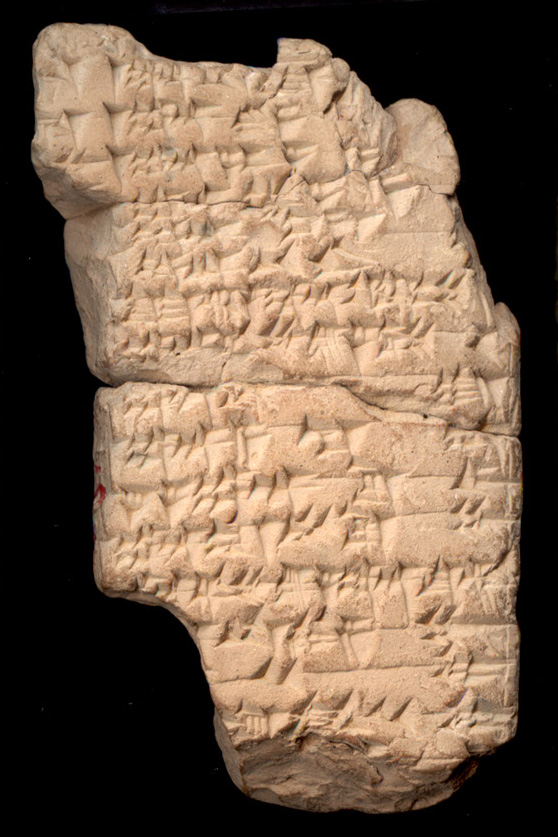Mesopotamian Constellations and Their Legacy

- Cuneiform tablet with ziqpu star list.
- Kelsey Museum 89551, University of Michigan.
This cuneiform tablet preserves part of a list of twenty-five stars or small star groups. The stars are arranged in the order that they cross the north-south meridian at the highest point of their daily journey across the sky (an event known as culmination).
The Babylonian sky was inhabited by a large number of constellations. These constellations were named after various animals, gods, people, and inanimate objects. The constellations were grouped into three “paths” in the sky associated with three of the principle gods in the Babylonian pantheon. The northern constellations were assigned to the path of the god Enlil. Among these constellations were the Great Twins, the Crab, the Lion, and the Wagon, which correspond to Gemini, Cancer, Leo, and the Big Dipper. In the middle of the sky are the stars in the path of Anu, which include the Bull of Heaven, the True Shepherd of Anu, and the Balance, respectively Taurus, Orion, and Libra, as well as a constellation called simply the Stars, corresponding the Pleiades. In the south are the stars in the path of Ea, which include the Scorpion, the Pabilsag (named after a god), and the Goat-Fish, corresponding to Scorpio, Sagittarius, and Capricorn.
The Babylonians also identified eighteen or so constellations “in the path of the moon” through which the moon, sun, and planets move. These are the zodiacal constellations which are distributed around the ecliptic. In the late fifth century BCE, the Babylonians developed the concept of a uniformly divided zodiac of twelve signs, each of which is divided into 30 degrees. The signs of the zodiac were named after constellations situated within each sign. The most common set of names for the zodiacal signs used by the Babylonians was: the Hired Man, the Stars, the Twins, the Crab, the Lion, the Furrow, the Balance, the Scorpion, Pabilsag, the Goat-Fish, the Great One, and the Tails. Both the concept of the zodiac and many of the names for the signs circulated widely in the ancient world and are still used today.
The tablet shown here, which dates to sometime during the last three-quarters of the first millennium BCE and was probably written in the city of Babylon, is one of several tablets to contain lists of successively culminating stars. These stars were called ziqpu stars by the Babylonians (the word ziqpu means “highest point”). Among the preserved entries on the tablet are stars from the constellations the Lady of Life, the Demon with the Open Mouth, the Stag, the Old Man, and the Crook. A text containing descriptions of the constellations (MLC 1866) portrays the Demon with the Open Mouth as follows:
The Demon with the Open Mouth (is) Nergal: the leader going in front. He is a human figure, clothed, wearing a tiara. Two are his faces. The front face is the face of a human figure. The back face is that of a lion, bearded, mouth open, having wings; its right shin (and) its ankle are three fold.
In addition to the names of the ziqpu stars, the tablet gives the intervals in degrees between the stars. These intervals correspond to differences in their right ascension or, equivalently, time intervals measured in 360ths of a day between their culminations. The ziqpu stars could be used to record the time at night and formed the basis for so-called rising time schemes which can be used to determine the length of day and night and the time it takes for a sign of the zodiac to rise or set. Similar material is found in the writings of Greek astronomers including Hypsicles, Hipparchus, and Geminus.
Select Bibliography
- Beaulieu, Paul-Alain, Eckart Frahm, Wayne Horowitz, and John M. Steele. 2018. The Cuneiform Uranology Texts: Drawing the Constellations. Transactions of the American Philosophical Society. Vol. 107, part 2. Philadelphia: American Philosophical Society Press.
- Götze, Albrecht, and Foster, Benjamin R. 2009. Cuneiform Texts from Various Collections. Yale Oriental Series. Vol. 15. New Haven, Conn: Yale University Press: no. 7.
- Steele, John M. 2017. Rising Time Schemes in Babylonian Astronomy. Springer Briefs in the History of Science and Technology. Dordrecht: Springer International Publishing.
- Steele, John M. 2014, “Late Babylonian ziqpu-star Lists: Written or Remembered Traditions of Knowledge?”, in Traditions of Written Knowledge in Ancient Egypt and Mesopotamia: Proceedings of Two Workshops Held at Goethe-University, Frankfurt/Main in December 2011 and May 2012, edited by D. Bawanypeck and A. Imhausen. Alter Orient und Altes Testament. Band 403. Münster: Ugarit-Verlag, 2014: pp. 123–151.